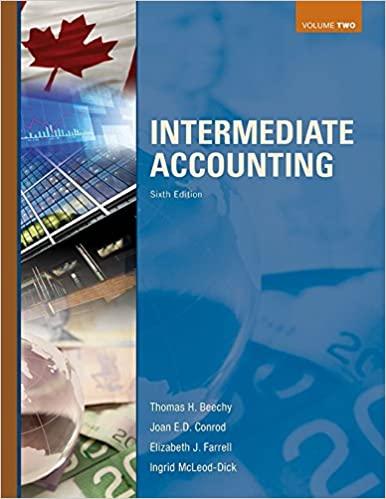Special People Industries (SPI) is a nonprot organization that employs only people with physical or mental disabilities. One of the organization's activities is to make cookies for its snack food store. Several years ago, Special People Industries purchased a special cookiecutting machine. As of December 31, 20x0, this machine will have been used for three years. Management is considering the purchase of a newer, more efcient machine. If purchased, the new machine would be acquired on December 31, 20x0. Management expects to sell 300,000 dozen cookies in each of the next six years. The selling price of the cookies is expected to average $1.15 per dozen. Special People Industries has two options: continue to operate the old machine or sell the old machine and purchase the new machine. No tradein was offered by the seller of the new machine. The following information has been assembled to help management decide which option is more desirable. Old New Machine Machine Original cost of machine at acquisition $88,888 $128,888 Remaining useful life as of December 31, 28x8 6 years 6 years Expected annual cash operating expenses: Variable cost per dozen $ 8.33 $ 8.29 Total 'Fixed costs $21,888 $ 11,888 Estimated cash value of machines: December 31, 28x8 $48,888 $128,888 December 31, 28x6 $ 7,888 $ 28,888 Assume that all operating revenues and expenses occur at the end of the year. Use Appendix A for your reference. (Use appropriate factos) from the tables provided.) Required: 1-0. Use the netepresentevalue method to compute the netrpresentrvalue for the old machine and the new machine. The organization's hurdle rate is 16 percent. 1-b. Determine whether Special People Industries should retain the old machine or acquire the new machine. Future Value and Present Value Tables Table I Future Value of $1.00(1 + r)" Period 4% 6% 10% 12% 14% 20% 1 1.040 1.060 1.080 1.100 1.120 1.140 1.200 2 1.032 1.124 1.166 1.210 1.254 1.300 1.440 3 1.125 1.191 1.260 1.331 1.405 1.482 1.728 4 1.170 1.263 1.361 1.464 1.574 1.689 2.074 5 1.217 1.338 1.469 1.611 1.762 1.925 2.488 6 1.265 1.419 1.587 1.772 1.974 2.195 2.986 7 1.316 1.504 1.714 1.949 2.211 2.502 3.583 8 1.369 1.594 1.851 2.144 2.476 2.853 4.300 9 1.423 1.690 1.999 2.359 2.773 3.252 5.160 10 1.480 1.791 2.159 2.594 3.106 3.707 6.192 11 1.540 1.898 2.332 2.853 3.479 4.226 7.430 12 1.601 2.012 2.518 3.139 3.896 4.818 8.916 13 1.665 2.133 2.720 3.452 4.364 5.492 10.699 14 1.732 2.261 2.937 3.798 4.887 6.261 12.839 15 1.801 2.397 3.172 4.177 5.474 7.138 15.407 20 2.191 3.207 4.661 6.728 9.646 13.743 38.338 30 3.243 5.744 10.063 17.450 29.960 50.950 237.380 40 4.801 10.286 21.725 45.260 93.051 188.880 1,469.800Table II (1 + r)" - 1 Future Value of a Series of $1.00 Cash Flows (Ordinary Annuity) Period 4% 6% 10% 12% 14% 20% 1.000 1.000 1.000 1.000 1.000 1.000 1.000 2.040 2.060 2.080 2.100 2.120 2.140 2.220 3 3.122 3.184 3.246 3.310 3.374 3.440 3.640 4 4.247 4.375 4.506 4.641 4.779 4.921 5.368 5.416 5.637 5.867 6.105 6.353 6.610 7.442 6 6.633 6.975 7.336 7.716 8.115 8.536 9.930 7 7.898 8.394 8.923 9.487 10.089 10.730 12.916 9.214 9.898 10.637 11.436 12.300 13.233 16.499 10.583 11.491 12.488 13.580 14.776 16.085 20.799 10 12.006 13.181 14.487 15.938 17.549 19.337 25.959 11 13.486 14.972 16.646 18.531 20.655 23.045 32.150 12 15.026 16.870 18.977 21.385 24.133 27.271 39.580 13 16.627 18.882 21.495 24.523 28.029 32.039 48.497 14 18.292 21.015 24.215 27.976 32.393 37.581 59.196 15 20.024 23.276 27.152 31.773 37.280 43.842 72.035 20 29.778 36.778 45.762 57.276 75.052 91.025 186.690 30 56.085 79.058 113.283 164.496 241.330 356.790 1,181.900 40 95.026 154.762 259.057 442.597 767.090 1,342.000 7,343.900Table III 1 Present Value of $1.00 (1 + +) Period 4% 6% 8% 10% 12% 14% 16% 18% 20% 22% 24% 26% 28% 30% 32% .962 .943 .926 .909 .893 .877 .862 .847 .833 .820 .806 .794 .781 .769 .758 .925 .890 .857 .826 .797 .769 .743 .718 .694 .672 .650 .630 .610 .592 .574 3 .889 .840 .794 .751 .712 .675 .641 .609 .579 .551 .524 .500 .477 .455 .435 .855 .792 .735 .683 .636 .592 .552 .516 .482 .451 .423 .397 .373 .350 .329 .822 .747 .681 .621 .567 .519 .476 437 .402 .370 .341 .315 .291 .269 .250 6 790 .630 .564 .507 .456 .410 .370 .335 303 .275 .250 .227 .207 .189 7 .760 .665 .583 .513 .452 .400 .354 .314 .279 .249 .222 .198 .178 .159 .143 S .731 .627 .540 .467 .404 .351 .305 .266 .233 .204 .179 .157 .139 .123 .108 9 .703 .592 .500 .424 .361 .30S .263 .225 .194 .167 .144 .125 . 108 .094 .082 10 .676 .558 .463 .386 .322 .270 .227 .191 .162 .137 .116 .099 .085 .073 .062 11 .650 .527 .429 .350 .287 .237 .195 .162 .135 .112 .094 .079 .066 .056 .047 12 .625 497 .397 .319 .257 208 .168 .137 .112 092 076 .062 .052 .043 .036 13 .601 .469 .368 .290 .229 .182 .145 .116 .093 .075 .061 .050 .040 .033 .027 14 577 .442 .340 .263 .205 .160 .125 .099 .078 .062 .049 .039 .032 .025 .021 15 .555 .417 .315 .239 . 183 .140 .108 .084 .065 .051 .040 .031 .025 .020 .016 20 .456 .312 .215 .149 .104 .073 .051 .037 .026 .019 .014 .010 .007 .005 .004 30 .308 .174 .099 .057 .033 .020 .012 .007 .004 .003 .002 .001 .001 40 .208 .097 .046 .022 .011 .005 .003 .001 .001\fReq 1A N Req 1 B Use the netpresentvalue method to compute the netpresentvalue for the old machine and the new machine. The organization's hurdle rate is 16 percent. {Negative amounts should be indicated by minus sign.} Old machine New machine Req 1A Determine whether Special People Industries should retain the old machine or acquire the new machine. Determine whether Special People Industries should retain the old machine or acquire the new machine













